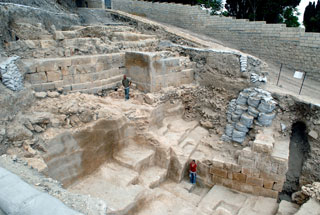
The lines of the wall that delineate Mount Zion from the west and the south were first discovered and excavated at the end of the nineteenth century (1894-1897) by the Palestine Exploration Fund, under the direction of the archaeologist Frederick Jones Bliss and his architect assistant, Archibald Dickie. The work methods they employed involved the excavation of shafts that were linked by subterranean tunnels which ran along the outer face of the city walls.
Over the years their shafts and tunnels have filled up with soil and a year and a half ago when archaeologists were asked to determine the location of the areas that were excavated one hundred years ago they were unsuccessful in doing so. By cross-referencing the plans of the old excavation with updated maps of the area from today archaeologist Yehiel Zelinger was able to locate the tunnel which the British expedition had dug. There remained in it “souvenirs” that were left behind by the early excavators in the form of one of the laborer’s shoes, the top of a gas light which was used to illuminate the tunnels, as well as fragments of beer and wine bottles from 120 years ago.
According to Yehiel Zelinger, excavation director on behalf of the Israel Antiquities Authority, “Having located the two city walls on Mount Zion corroborates our theory regarding the expansion of the city toward the south during these two periods, when Jerusalem reached its largest size. In the Second Temple period the city, with the temple at its center, was a focal point for Jewish pilgrimage from all over the ancient world and in the Byzantine period it attracted Christian pilgrims who came in the footsteps of the story of the life and death of their messiah. The exposure of the Hasmonean city wall and the line of fortifications from the Byzantine period, which is dated 400 years later and is right on top of the former, prove that this is the most advantageous topographic location for the defense of the city. The artifacts indicate that in spite of the fact that the builders of the Byzantine wall were unaware of the existence of the wall from the time of the Second Temple they constructed their wall precisely along the same route”.
Zelinger adds, “The fact that after 2,100 years the remains of the first city wall were preserved to a height of three meters is amazing. This is one of the most beautiful and complete sections of construction in the Hasmonean building style to be found in Jerusalem”.
No comments:
Post a Comment